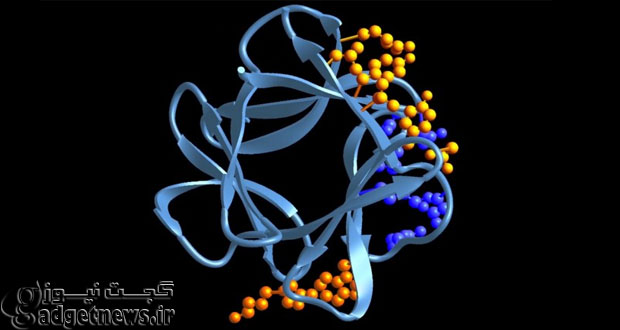بیماری دیابت نوع دوم یکی از شایع ترین بیماری های امروزی است که متاسفانه افراد بسیاری از آن رنج می برند.به همین دلیل تا امروز تلاش های بسیاری برای یافتن یک درمان موثر و سریع برای این بیماری انجام شده است.اکنون دانشمندان موسسه تحیقاتی سالک ( Salk ) موفق به کشف نوعی پروتئین خاص به نام FDF1 شده اند که باتزیق آن به موش های آزمایشگاهی مبتلا به این نوع بیماری موفق به پایین آوردن سریع سطح قند خون آنها به حد نرمال شدند.
اگرچه دیابت نوع دوم اغلب در مراحل اولیه از طریق یک رژیم غذایی سالم و تمرینهای ورزشی منظم قابل کنترل میباشد، اما قرصهایی هم به منظور تقویت سطح انسولین تولیدی بدن استفاده میشوند که معمولا با پیشرفت بیماری تجویز میشوند. این قرصها میتوانند اثرات جانبی داشته باشند مانند تهوع و اسهال، و از این رو برای همهی بیماران مانند زنان باردار و افراد مبتلا به ناراحتی کبد، کلیه یا بیماری قلبی، مناسب نیستند. این قرصها همچنین میتوانند بر افت سطح گلوکز خون تاثیر داشته باشند که منجر به کاهش قند خون خواهد شد.
اکنون محققان موسسهی سالک دریافتند که تزریق سریع یک دوز پروتئین FGF1 به موشهای مبتلا به مشابه بیماری دیابت نوع دوم انسانها، سطح گلوکز خون آنها را به سطح نرمال بازمیگرداند و برای مدت زمان دو روز حالت طبیعی موشها حفظ خواهد شد. مسالهی مهمتر اینکه حتی با تزریق دوزهای بالا، در موشها اثرات جانبی معمول شیوههای رایج درمان دیابت مانند افزایش وزن یا مشکلات قلبی و کبدی رخ نخواهد داد.
Jae Myoung Suh، از محققان سالک، میگوید: “در استفاده از FDF1 ما درواقع اثرات جانبی ناشی از کاهش قند خون و سایر مشکلات را مشاهده ننمودهایم. شاید FGF1 بتواند خود را به عنوان آغازی برای یافتن یک شیوهی درمانی طبیعی در مقایسه با دیگر داروها ثابت نماید.”
همانند مکانیزم مقاومت در برابر انسولین که موجب بیماری دیابت میشود، گروه موسسهی سالک اعلام کردهاند که مکانیزم نرمالسازی سطح قند خون توسط FGF1 چندان مشخص نیست. اما با وجود اینکه FGF1 یک عامل رشد محسوب میشود، این گروه متوجه شدند که توانایی این پروتئین در تحریک رشد از اثرات آن بر روی سطح گلوکز خون کاملا مجزا بوده، از این رو شانس استفاده از آن به عنوان یک داروی دیابتی کارا و ایمن افزایش مییابد.
Ronald M. Evans، سرپرست آزمایشگاه سالک میگوید: “ما میخواهیم نسل جدیدی از پروتئین FGF1 را ایجاد کنیم که فقط بر سطح گلوکز و نه بر میزان رشد تاثیر داشته باشند. اگر موفق به این کار شویم و بتوانیم نسل کاملی را توسعه دهیم، فکر میکنم به یک ابزار کاملا جدید و موثر در کنترل گلوکز دست خواهیم یافت.”
ایوان و گروه وی در پی برنامهریزی تستهای انسانی هستند، اما توسعه و تنظیم دقیق سطح این پروتئین برای چنین تستهایی نیاز به زمان بیشتری دارد.
جالب است بدانید یکی از اعضای این تیم تحقیقاتی هموطن ایرانی خانم مریم احمدیان هستند.
نتایج تحقیقات این گروه در ژورنال Nature منتشر شده و در ویدئویی به شرح دستاوردهای این گروه پرداخته شده که میتوانید آن را در ادامه مشاهده کنید.
منبع : gizmag
Single injection reverses type 2 diabetes symptoms in mice without side effects
Single injection reverses type 2 diabetes symptoms in mice without side effects
There are numerous research efforts underway to develop new treatments and improve the lives of people suffering type 2 diabetes, whose ranks have increased dramatically in recent decades due in large part to the so-called obesity epidemic. A new generation of safer and more effective diabetes drugs could be in the offing with researchers at the Salk Institute discovering that when mice with diet-induced diabetes were given a single injection of a protein, their blood sugar levels were restored to a healthy range for more than two days.
Although type 2 diabetes can sometimes be managed through a healthy diet and regular exercise in the initial stages, tablets that boost the body’s production of insulin are generally prescribed as the disease progresses. Such tablets can have side effects, including nausea and diarrhea, and aren’t suitable for everyone, such as pregnant women and those with severe liver, kidney or heart disease. They can also cause blood glucose levels to drop too low, potentially resulting in hypoglycemia.
Now Salk researchers have found that injecting obese mice with the equivalent of type 2 diabetes in humans with a single dose of protein FGF1 quickly restored their blood glucose levels to normal levels where they remained for more than two days. Importantly, even when given high doses, the mice suffered none of the side effects common to most current diabetes treatments, such as weight gain or heart and liver problems.
“With FGF1, we really haven’t seen hypoglycemia or other common side effects,” says Salk postdoctoral research fellow Jae Myoung Suh. “It may be that FGF1 leads to a more ‘normal’ type of response compared to other drugs because it metabolizes quickly in the body and targets certain cell types.”
Like the mechanism of insulin resistance that causes diabetes, the team says the mechanism responsible for FGF1 normalizing blood sugar levels isn’t fully understood. But despite FGF1 being a growth factor, the team found that its ability to stimulate growth was independent of its effects on blood glucose levels, thereby increasing the chances of it being used to develop safer, more effective diabetes drugs.
“We want to move this to people by developing a new generation of FGF1 variants that solely affect glucose and not cell growth,” says says Ronald M. Evans, director of Salk’s Gene Expression Laboratory. “If we can find the perfect variation, I think we will have on our hands a very new, very effective tool for glucose control.”
Evans and his team are planning to conduct human trials of FGF1, but admit fine-tuning the protein into a therapeutic drug will take time.
The team’s paper is published in the journal Nature and a video detailing the discovery can be viewed below.
 گجت نیوز آخرین اخبار تکنولوژی، علم و خودرو
گجت نیوز آخرین اخبار تکنولوژی، علم و خودرو 






